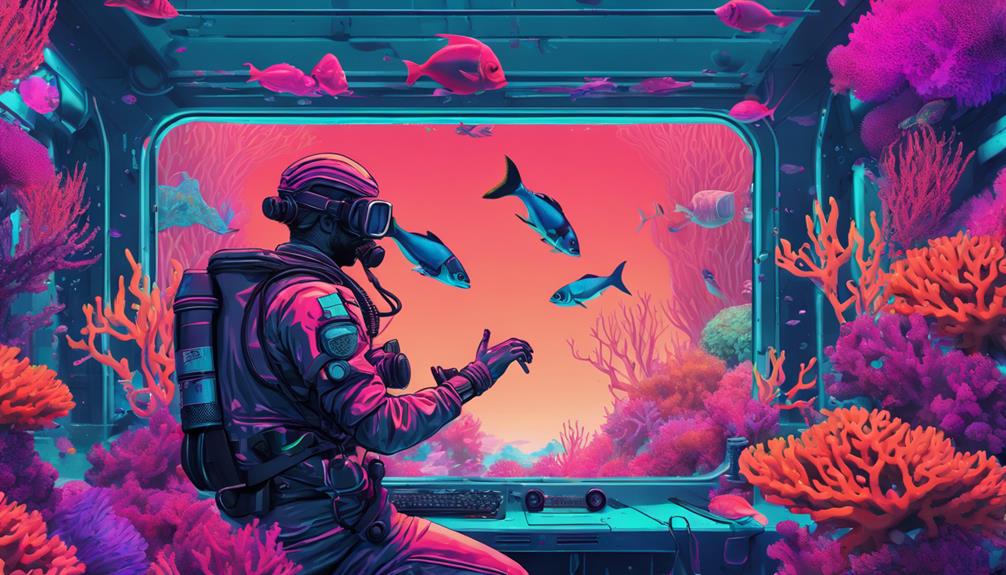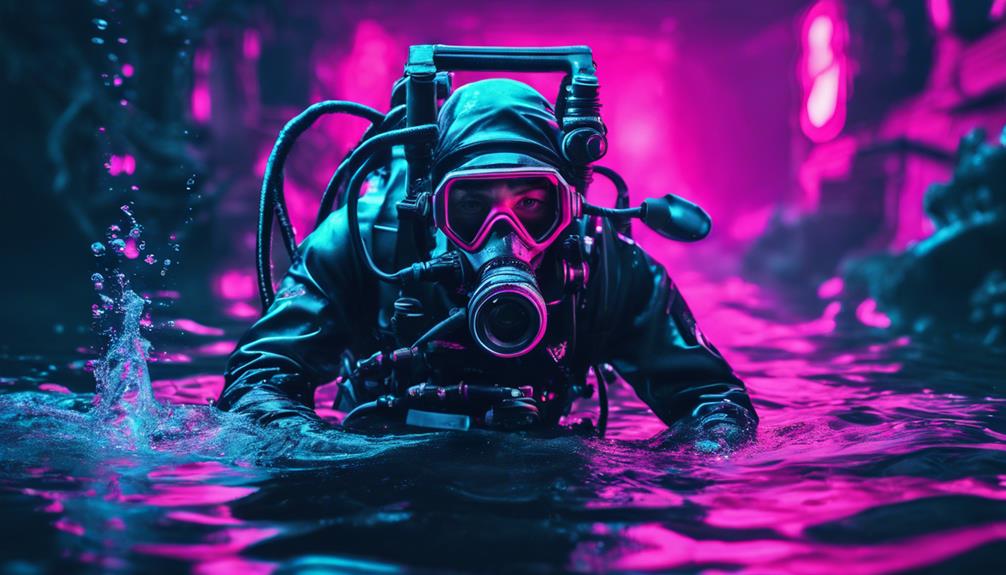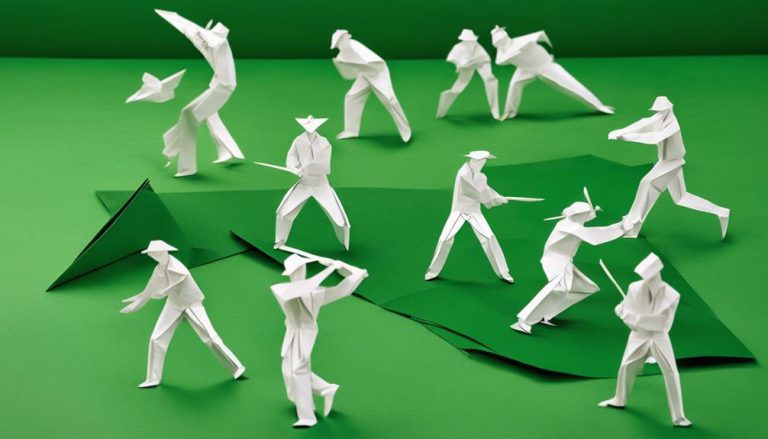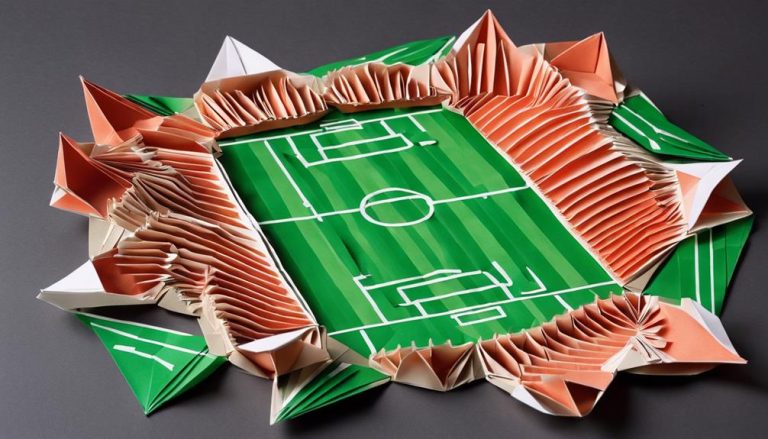General Rules of Underwater Photography
Are you struggling to capture stunning underwater photos that truly stand out?
From mastering lighting techniques to adjusting camera settings, there are essential rules every underwater photographer should follow.
But what about those often overlooked factors that can make or break your shots?
Stay tuned to uncover the key principles that will elevate your underwater photography game to the next level.
Equipment Essentials
When diving into underwater photography, you'll need to equip yourself with essential gear that will enhance your shooting capabilities. Proper maintenance of your equipment is crucial for ensuring longevity and optimal performance. Before each dive, check all seals, O-rings, and housing to prevent leaks that could damage your camera. Regularly clean your gear with fresh water after use to remove salt and debris, preserving its functionality.
Diving safety is paramount when engaging in underwater photography. Ensure you're well-versed in diving procedures and techniques before attempting to capture images below the surface. Always dive with a buddy for added safety and support. Familiarize yourself with the specific hazards of underwater photography, such as entanglement or disorientation, and have a clear plan in place to address any emergencies that may arise.
Invest in a sturdy camera housing that suits your specific camera model to protect it from water damage. Consider adding accessories like strobes or video lights to enhance your images in different lighting conditions. A good quality lens with a focal length suitable for underwater shooting is essential for capturing sharp and vibrant images. Remember to always secure your gear properly during dives to prevent accidents and ensure a smooth shooting experience.
Mastering Lighting Techniques
To enhance the quality of your underwater photographs, mastering lighting techniques is essential for capturing stunning and visually compelling images. When diving into the depths, understanding the nuances of light can make all the difference in your photography. Here are some key points to consider:
- Natural vs artificial lighting: Underwater, natural light behaves differently than on land. Experiment with both natural light filtering through the water and artificial lighting from your equipment to see which enhances your subject best.
- Depth perception techniques: To convey depth in your images, use lighting to create shadows and highlights. This can add a sense of dimensionality to your photos, making them more captivating.
- Positioning of light source: Depending on the angle of your light source, you can create different effects. Try positioning the light above, below, or to the side of your subject to see how it alters the mood of the photograph.
- Using light to reveal details: Play with the intensity of light to highlight specific features of underwater subjects. Illuminating certain parts can draw the viewer's eye to critical elements in the frame.
- Avoiding backscatter: Backscatter occurs when light reflects off particles in the water, causing unwanted specks in your photos. Adjust your lighting angles and settings to minimize this effect and keep your images clear and sharp.
Understanding Composition Principles

Understanding composition principles is crucial for creating visually appealing and well-balanced underwater photographs. When capturing underwater scenes, incorporating leading lines can guide the viewer's eye through the image, creating a sense of depth and dimension. These lines can be actual elements like coral reefs, rock formations, or even the graceful movements of marine life. By strategically positioning these leading lines within your frame, you can add interest and visual impact to your photos.
In addition to leading lines, negative space plays a significant role in composition underwater. Negative space refers to the areas around the main subject that are left intentionally unoccupied. In underwater photography, negative space can help draw attention to the subject by providing a clean and uncluttered background. This technique can evoke a sense of tranquility and highlight the beauty of the underwater world.
Adjusting Camera Settings
Optimizing your camera settings is essential for capturing high-quality underwater photographs. To achieve the best results, consider the following adjustments:
- Exposure Control: Underwater lighting can be challenging, so mastering exposure settings is crucial. Adjust your camera's ISO, shutter speed, and aperture to control the amount of light entering the lens and prevent overexposure or underexposure.
- White Balance: Water absorbs different colors of light, leading to a color cast in your photos. Set the white balance according to the water conditions to ensure accurate color reproduction. You may need to use custom white balance settings or underwater filters to correct color shifts.
- Focus Points: Selecting the right focus points is key to achieving sharp and well-defined images. Utilize single-point autofocus or manual focus to pinpoint specific subjects and avoid focus hunting in challenging underwater environments.
- Aperture Settings: Adjusting the aperture not only controls the amount of light but also influences the depth of field in your photos. Use a larger aperture (small f-number) for a blurred background or a smaller aperture (higher f-number) to keep more of the scene in focus.
Mastering these camera settings will enhance the quality of your underwater photography, allowing you to capture stunning images that truly reflect the beauty of the underwater world.
Dealing With Water Conditions

Mastering underwater photography also involves effectively managing various water conditions to ensure optimal image quality. When dealing with different water conditions like water visibility and challenging currents, it's essential to adapt your techniques to capture stunning underwater shots.
Dealing With Water Conditions
To navigate through varying water conditions successfully, consider the following factors:
| Water Visibility | Challenging Currents |
|---|---|
| Clear water is ideal for capturing sharp details and vivid colors in your photos. Make sure to adjust your camera settings accordingly. | Strong currents can make it challenging to stay in position to take a clear shot. Using a camera with fast autofocus capabilities can help you capture sharp images even in turbulent waters. |
| Murky or low visibility water may require you to get closer to your subject to reduce the amount of particles between you and the subject. Consider using a focus light to assist your camera in focusing properly. | Work with the current rather than against it. Position yourself strategically to use the current to your advantage in getting the perfect shot. |
Post-Processing Tips
When processing your underwater photographs, it's essential to utilize editing tools to enhance the quality of your images effectively. To make the most of your underwater shots, consider the following post-processing tips:
- Color Correction: Adjust the color balance to bring out the true colors of the underwater world. Correcting the color cast caused by water can make a significant difference in the vibrancy of your images.
- Enhancing Details: Use sharpening tools to bring out intricate details in your underwater photos. Enhancing the details can make your subject pop and create a more captivating image.
- Removing Distractions: Eliminate any distracting elements from your underwater photographs. Whether it's debris in the water or unwanted marine life in the background, clean up your composition for a more polished look.
- Adding Filters: Experiment with filters to enhance the overall mood of your underwater images. Filters can help control the light, reduce glare, or add a creative twist to your photos.
Frequently Asked Questions
How Can I Best Capture the Movement and Behavior of Marine Life in My Underwater Photos?
To capture marine life's movement and behavior in your underwater photos, focus on mastering lighting techniques and camera settings. Use composition ideas to showcase interactions creatively. Dive deep into the art of underwater photography.
What Are Some Tips for Staying Safe While Diving and Taking Photos Underwater?
To ensure safety underwater, follow these safety precautions: check equipment maintenance regularly, always dive with a buddy, maintain proper buoyancy control, respect marine life, avoid touching corals, and be aware of your surroundings at all times.
Are There Any Regulations or Guidelines I Should Be Aware of When Photographing Underwater Environments?
When photographing underwater, remember to follow regulations to protect marine life. Consider lighting techniques and post-processing options for stunning shots. Maintain equipment properly to avoid malfunctions. Be mindful of the environmental impact of your actions.
How Can I Effectively Communicate the Scale and Depth of Underwater Scenes in My Photos?
To effectively communicate scale and depth in underwater scenes, consider using lighting techniques for contrast, color correction for vibrancy. Experiment with focal length for perspective, and utilize composition techniques like leading lines or framing to guide the viewer's eye.
What Are Some Common Mistakes to Avoid When Taking Underwater Photos, and How Can I Improve My Technique to Prevent Them?
When diving into underwater photography, avoid common mistakes like poor lighting and cluttered compositions. Sharpen your skills by mastering lighting techniques and composition tips. Keep equipment maintained and embrace editing software for flawless shots.






